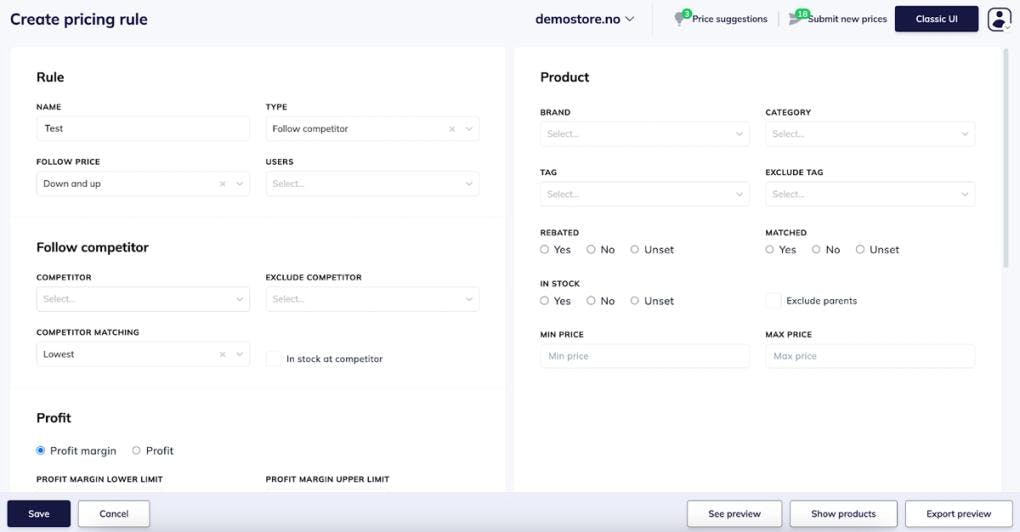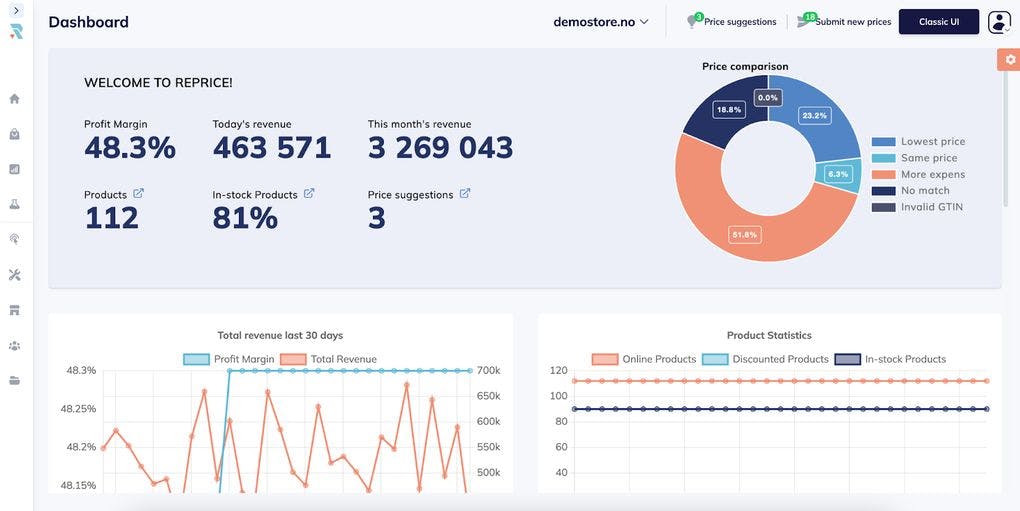5 Ways To Secure And Simplify Compliance With Pricing Regulations
April 19, 2024 | 10 minutes read
Setting the right prices is one thing - but staying in line with pricing rules and regulations is another.
The process itself can be complex and challenging. Reason being that e-commerce companies are often overwhelmed by the sheer volume of data there is - faced with the mix of new regulatory compliance demands that come into place.
However, with the right pricing strategies in place, and tools, pricing rule compliance can be both secured and simplified without too much effort or hassle.
Today, not using pricing optimization software could mean missing out on making your entire pricing process much more efficient, automated and, in the end, successful.
And as market conditions grow more complex and regulatory demands tighten, companies without these tools could struggle to not only stay compliant, but also competitive.
In this article, we’ll discuss 5 easy ways your company can easily comply with pricing rules and regulations today without compromising efficiency and time spent optimizing your pricing game.
In this article:
- Recap on new Norwegian pricing regulations
- How to secure compliance with pricing regulations
- Conclusion
Recap on new Norwegian pricing regulations
New Norwegian pricing regulations came into effect from October in 2023. They were designed to boost consumer protection and at the same time clarify rights - especially in the e-commerce and digital services game.
In line with the EU 2019/2161 directive, the changes modify four existing directives in order to put out more strict rules when it comes to pricing practices. Here’s what you need to know:
- A key regulation is the 30-day benchmark. This new rule states that discount labels can only be applied if the current price is compared to the lowest price of the product, in the previous 30 days.
- Second, if your prices are personalized through automated systems, you need to disclose this to your consumers before they make any kind of transaction. This helps enhance transparency and provide your customers with more control over what they spend their money on.
- Third, prices offered to loyalty clubs need to be included in the base price calculation for discounts. This helps ensure that promotions are fairly represented across the board.
Worth noting is that these regulations were put in place with the aim of creating greater consumer trust, ensuring legal compliance, supporting fair competition, and aligning Norwegian standards with the broader European practices going forward.
5 ways to secure compliance with pricing regulations
Ensuring you have the right compliance with pricing regulations doesn't have to be daunting.
By adopting these five strategies, you’ll not only ensure that your company meets any legal standards - but that it also optimizes its pricing processes for better efficiency and reliability:
1. Gain an understand of relevant regulatory requirements
First things first: Ensuring better compliance starts with understanding the key pricing regulations that will impact your company.
In other words, you need to not only get to grips with just the rules specific to your industry - but also those that are applied where your specific business is operating.
Luckily for you, some pricing optimization tools today can lessen the “workload” of always keeping an eye out for and staying in line with pricing rules - Reprice handles all of this for you already (which we will get into in the next section).
A general tip to keep on top of any changes to updates to pricing laws and regulations is to follow e-commerce news, subscribe to industry newsletters or set up alerts. Making sure you stay informed means that you’ll adapt smoothly to new changes and maintain compliance without too much effort.
2. Leverage pricing automation for discount calculation
The next step involves leveraging pricing optimization software that helps you automate your pricing operations. Tools like Reprice come in handy as they allow you to automate pricing, increase margins and implement a more competitive and profitable e-commerce pricing strategy.
Besides just allowing you to go from a more reactive to proactive pricing strategy, Reprice helps you sustain compliance to regulations by four ways:
1. Analyzing past pricing data
Closely reviewing your past pricing data is the pillar of this approach. Reprice can quickly check the lowest prices that your products have hit in the last 30 days to make sure discounts are set accurately.
Picture the following example: If a product was originally priced at 3200 NOK and then dropped to 2400 NOK during a sale, Reprice calculates a 25% discount from this lowest price (which of course is in line with the 30-day rule). This approach makes sure that the discounts are not only compliant, but fair too.
2. Helps excludes specific products
This second strategy uses advanced data filtering to keep everything running correctly, and smoothly.
It works pretty straightforward: Reprice automatically scans for any of your products that might be breaking pricing rules, and without you having to do anything, automatically excludes them from any discount promotions.
So let’s say there's an upcoming campaign for a specific brand. If Reprice finds any items from that brand that were priced below the list price in the past 30 days, it efficiently leaves these out of the discount plan.
The result? Making sure everything stays compliant and trouble-free.
3. Adjusts list prices
If you happen to run into any situations where there’s a pricing breach, Reprice can adjust the list prices to sidestep the label of "discounted."
Say you’ve put out a promotion offering a 25% discount on a certain product. If Reprice discovers that some items have been sold at lower prices recently, it tactfully corrects their list prices. That way it all stays compliant without openly advertising the products at a discount price.
4. Tailors discount percentages
Take the following scenario: If a product was originally priced at 3150 NOK but then recently reduced to 2850 NOK, Reprice calculates a precise 17.46% discount, rather than 25%, adhering to the 30-day guideline.

Want to learn more about the regulations?
Contact us today to dive deeper into the details. We're here to help.
3. Keep a comprehensive audit trail
The next strategy and step is key for multiple reasons - when it comes to securing compliance with rules and regulations.
Maintaining an audit trail helps you provide verifiable documentation of the pricing changes and decisions you make. Which in a lot of cases is a prerequisite for showing that you actually adhere to legal standards during regulatory reviews or audits, should the consumer authority ask for documentation.
This kind of reporting and documentation is something that pricing software like Reprice will handle for you, so you don’t have to take on the hassle yourself.
Making sure your prices stay consistent across multiple (physical and online) sales channels has never been easier as Reprice integrates with different e-commerce platforms and ERP systems that you use already. The bottom line is that consistent pricing helps in maintaining a clear and unified record of pricing decisions, which is important for auditing purposes.
Overall, you streamline your management of pricing data, helping improve the reliability of the audit trail. Making it much easier for e-commerce companies to maintain better compliance with pricing regulations.

4. Always proactively address any compliance issues
If you ever run into any compliance issues, your best bet is to start working through them immediately. That’s why it’s highly recommended that you monitor pricing data regularly, and address any deviations from regulatory requirements as fast as you see them coming.
Monitoring pricing data in general is a great way to make sure you stay up to speed with market trends and ensure that your pricing remains competitive.
Reprice offers real-time insights into competitor pricing and market strategies. This access to updated and current pricing information is invaluable when it comes to maintaining regulatory compliance. With the tool’s "bird's-eye view" dashboard, you can easily and quickly identify new competitors on the scene, and from there, adapt your prices proactively to stay competitive.
With these features at your fingertips, you can easily remain compliant and prioritize which competitors to stay up to speed with, helping you move beyond manual tracking methods like Excel or Google Docs.

5. Consider investing in robust employee training
Even with advanced tools like Reprice, human oversight is crucial.
That’s why investing in employee training and education can add another layer of guarantee that your team understands not only just the regulatory environment - but also how to use tools like Reprice effectively within these limits.
Education and training can include going through the rules themselves, delving into specific pricing optimization features and capabilities (like modifying pricing rules either manually or automatically), in addition to a broader form of compliance training.
Conclusion
It doesn’t have to be all too challenging to stay in line with pricing rules and regulations.
In fact, Reprice makes it easy.
To sum up, the tool streamlines pricing compliance by analyzing historical data for accurate discounts, automatically filtering out non-compliant products, adjusting list prices discreetly, and customizing discount percentages. Plus, ERP integration helps support a clear pricing audit trail.
Ready to get started with Reprice? Book a demo here.
Robin Frugaard Jørgensen
Chief Commercial Officer at Reprice
Robin Frugaard Jørgensen is Chief Commercial Officer at Reprice. Prior to joining Reprice in January 2023, Robin spent several years working with pricing strategies in B2B & the consumer electronics industry. Connect with Robin on LinkedIn here or book a demo to see how Reprice can solve your e-commerce pricing challenges.
